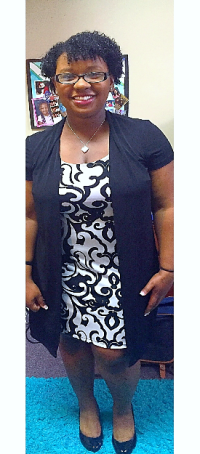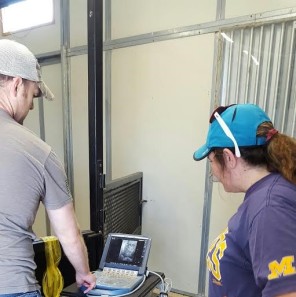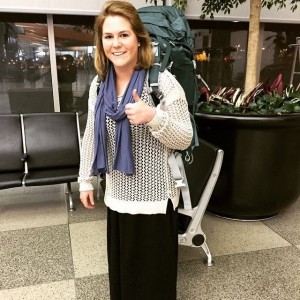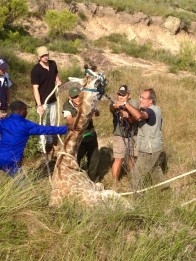 My name is Dorothy “Deedee” Cottonham and I am from Madison, Mississippi. I am an ongoing junior at Mississippi State University, majoring in Animal and Dairy Sciences with a concentration in Science/Veterinary Science. I plan to graduate from Mississippi State University with my Bachelors in Science, and continue on to graduate school.
My name is Dorothy “Deedee” Cottonham and I am from Madison, Mississippi. I am an ongoing junior at Mississippi State University, majoring in Animal and Dairy Sciences with a concentration in Science/Veterinary Science. I plan to graduate from Mississippi State University with my Bachelors in Science, and continue on to graduate school.
In trying to make sure that I take the necessary courses for veterinary school enrollment, as well as the graduate program in Animal and Dairy Sciences, I was introduced to the opportunity to engage in a hands-on internship. With this opportunity being offered to me, I researched summer internships for the summer of 2016, to connect with others in the Animal and Dairy Sciences industry and gain some hands-on experience within the field. In doing so, I came across the opportunity that Prestage Farms was offering for ongoing juniors majoring in Animal and Dairy Sciences. I applied for the internship and was offered an interview. I was then notified that I received the position.
My internship will include a 2 week rotation throughout the 2016 summer semester. In doing so, every two weeks I will be introduced to a different department of the Prestage Farms Incorporation headquarters in West Point, Mississippi. They have approximately 15 farms, 1 in which is a feed mill and another which is an Artificial Insemination farm. I will have the opportunity to visit many of the farms and receive knowledge and hands-on experience within each department.
WEEK 1
This week at the Prestage Farms Incorporation (Mississippi Division), I started my first week at the Artificial Insemination farm located in West Point, MS. On the first day I met up with my supervisor, to discuss how my overall internship experience at Prestage Farms Inc., would be held. I was told by supervisor that I will be visiting each farm division that is a part of the West Point headquarters. In order for me to do so, every two weeks, I will be assigned to a different division of the department. With each division comes different work hours, workloads, and responsibilities. I was then taken to meet the main office coordinator and we went over my schedule for the first farm that I was going to visit, the Artificial Insemination Farm (AI Farm). I was introduced to the Artificial Insemination Farm employees and team leaders that Monday.
There are three different departments within the AI farm. First is collecting the boar’s semen. At 5:00 am, one of the team leaders and his crew are out collecting semen from the boars to fill the required orders given to the company to fill that day. After collection, the semen is sent to the testing room. The semen is tested for its motility rate. After the semen is tested, an extender is added. The extender is applied by another employee of the AI farm. On Monday, Tuesday and Wednesday of this week, I had the opportunity to participate in testing the semen and then applying an extender to it to be packaged.
Once the semen is tested and applied to an extender, it is sent to the third stage of the AI Farm, packaging. In the packaging room, the temperature of the room is kept at 52 degrees F, to cool down the semen once it has reached the facility. In this facility, the semen is packaged through a machine. During this process, the semen is packaged, labeled and divided to be sent out to different farms around the state for insemination of a sow. For the work days of Thursday and Friday this week, I had the opportunity to work in packaging the semen to be sent out to other distributors.
In participating in the Artificial Insemination Farm this week, I have learned interesting aspects in regards to collecting semen from boars, testing the semen and packaging them for distribution.
WEEK 2
This week at Prestage Farms (Mississippi Division), I completed my last week in the Artificial Insemination (AI) farm, before beginning in a new department next week. This week at the AI farm, I continued to shadow in packaging the semen to be sent out to different farms across the state. In doing so, I got to participate in the packaging process. I also witness how this machine is operated and managed to minimize machine difficulties.
On Wednesday, I saw the packaging machine have some complications in the process of packaging the semen. With each malfunction, the operator stopped the machine and showed me the problem, and we both fixed each malfunction together.
At the end of the day on Wednesday, the packaging machine operator showed me how to send a machine malfunction report to the IT department of Prestage Farms. The following day, service representative assisted with the technical issues we were encountering. One malfunction was caused due to the needle, which inserts the semen into the package, being screwed on to loose. As we looked at the needle, we realized that due to the needle being too loose, it resulted in the machine inserting the wrong amount of semen into each package. Another issue that service rep assisted with was the package openings. With this machine, the packaging in which each semen is processed in, is also provided by the same company that issues out the machines. The service rep explained that the packages that Prestage Farms had ordered for the semen to be packaged in, was ordered during their malfunction period, which resulted in Prestage Farms receiving bad semen bags. With that, we realized that that was the cause for the multiple “Bag Malfunction” screens that appeared on the home screen of the machine, multiple times the day before.
Once fixing the problems that had occurred from the machine in the AI center, we were able to get it running again. It was running smoothly in time for us to fill the biggest order of this week, which consisted of over a hundred bags of semen to be sent to Carolina.
Friday of this week was my last day in the AI center. Many ladies within the center had brought cake and baked some pies, as a good bye present for me and the other intern. I have become fairly close to the ladies in the AI center. However, in order for me to continue to experience all the operations and departments within Prestage Farms, I will have to move to other departments. I will be working more with the genetic program of Prestage Farms next week as I move locations. I will be learning the necessary procedures that need to take place, once the piglets are born.
 My name is Meagan Johnson, and I am a junior majoring in Animal and Dairy Sciences at Mississippi State. I will be spending this summer working as an intern at the Emerald Coast Wildlife Refuge in Florida. Throughout this internship, I will have the opportunity to gain experience with Florida’s native wildlife and other exotic animals. As an intern, I will work with the wildlife health staff to rescue and rehabilitate injured or abandoned wildlife. My duties will range from performing initial exams of injured wildlife to working on various community outreach programs. This wide variety of experiences will be extremely beneficial to me as I work towards my goal of becoming a veterinarian. I’m very excited to start this internship, and I can’t wait to see what the next 12 weeks have in store for me!
My name is Meagan Johnson, and I am a junior majoring in Animal and Dairy Sciences at Mississippi State. I will be spending this summer working as an intern at the Emerald Coast Wildlife Refuge in Florida. Throughout this internship, I will have the opportunity to gain experience with Florida’s native wildlife and other exotic animals. As an intern, I will work with the wildlife health staff to rescue and rehabilitate injured or abandoned wildlife. My duties will range from performing initial exams of injured wildlife to working on various community outreach programs. This wide variety of experiences will be extremely beneficial to me as I work towards my goal of becoming a veterinarian. I’m very excited to start this internship, and I can’t wait to see what the next 12 weeks have in store for me! hours to prepare both sets of meals. Cleaning cages and enclosures also takes up a large part of the day, along with other various house-keeping duties. I’ve already learned a lot in my first week. On my first day there, I was taught to bottle feed the numerous orphaned raccoons that we have in our nursery. Once I was taught, I was responsible for feeding them throughout the day. I also learned to syringe-feed our many fledglings. On Friday, several of our opossum weanlings had begun to develop Metabolic Bone Disease due to calcium deprivation, so the veterinarian taught us about the disease, and we were instructed how to treat it. Next, I helped build and install new perches in the raven enclosure as part of their enrichment. Lastly, we had to treat a heron that is in critical condition after being entangled in a fishing line; the hook had torn off the skin and some of the tissue on both of his legs, and the line was entangled over his entire body. Hopefully, he will recover soon and we will be able to release him. I really loved learning about and working with all of the animals at the refuge, and I think this will be great experience.
hours to prepare both sets of meals. Cleaning cages and enclosures also takes up a large part of the day, along with other various house-keeping duties. I’ve already learned a lot in my first week. On my first day there, I was taught to bottle feed the numerous orphaned raccoons that we have in our nursery. Once I was taught, I was responsible for feeding them throughout the day. I also learned to syringe-feed our many fledglings. On Friday, several of our opossum weanlings had begun to develop Metabolic Bone Disease due to calcium deprivation, so the veterinarian taught us about the disease, and we were instructed how to treat it. Next, I helped build and install new perches in the raven enclosure as part of their enrichment. Lastly, we had to treat a heron that is in critical condition after being entangled in a fishing line; the hook had torn off the skin and some of the tissue on both of his legs, and the line was entangled over his entire body. Hopefully, he will recover soon and we will be able to release him. I really loved learning about and working with all of the animals at the refuge, and I think this will be great experience.


 My name is Zachary Moody and I am an Animal and Dairy Sciences major from McCool, Mississippi. I grew up on a small farm and have been involved in 4-H most of my life and I would like to pursue a career with the Mississippi State Extension Service after I graduate. This summer I will be interning at the Attala County Extension office under the County Director, Taylor Casey. I will be shadowing him and helping put on different programs and activities throughout the summer. I hope to learn about all of the different duties and activities this job involves so that after I graduate I am prepared and have experience when applying to work with the Extension Service.
My name is Zachary Moody and I am an Animal and Dairy Sciences major from McCool, Mississippi. I grew up on a small farm and have been involved in 4-H most of my life and I would like to pursue a career with the Mississippi State Extension Service after I graduate. This summer I will be interning at the Attala County Extension office under the County Director, Taylor Casey. I will be shadowing him and helping put on different programs and activities throughout the summer. I hope to learn about all of the different duties and activities this job involves so that after I graduate I am prepared and have experience when applying to work with the Extension Service. My name is Dorothy “Deedee” Cottonham and I am from Madison, Mississippi. I am an ongoing junior at Mississippi State University, majoring in Animal and Dairy Sciences with a concentration in Science/Veterinary Science. I plan to graduate from Mississippi State University with my Bachelors in Science, and continue on to graduate school.
My name is Dorothy “Deedee” Cottonham and I am from Madison, Mississippi. I am an ongoing junior at Mississippi State University, majoring in Animal and Dairy Sciences with a concentration in Science/Veterinary Science. I plan to graduate from Mississippi State University with my Bachelors in Science, and continue on to graduate school.









